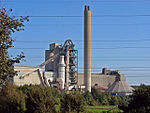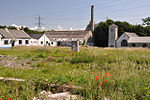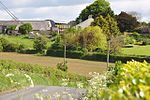Aberthaw Lime Works is a derelict structure, located on the South Wales coast, between Fontygary Bay and Aberthaw Power Station. The structure is a Grade II Listed Building. The structure is considered a listed building because it is a well preserved structure from an important regional industry.The Aberthaw Lime Works was opened on 22 December 1888, by the Aberthaw Pebble Limestone Company. It was built to utilise the huge number of Limestone Pebbles that had previously been taken inland or been moved by boat. The Lime Works operated until 1926. The Lime works brought a new scale of working to the lime industry which was really just a cottage industry in the area previously.The local limestone and brick structure is still largely intact, although it is missing most of its wooden components. It contains 2 vertical pot draw kilns each holding up to 300 tons each, which could produce up to 40 tons of burnt lime a day. Next to the main structure, there are 2 pot kilns which are also largely intact. These Kilns were built later than the main structure, but also ceased operation in 1926.The lime works were originally served by a tramway, which ran from the direction of Rhoose (east of the lime works). It passed either side of the now demolished winch house. A tramway ramp (again demolished) allowed carts containing pebbles between 3 & 4 inches (100 mm) in diameter to be conveyed to the top of the works and then into the kilns.









